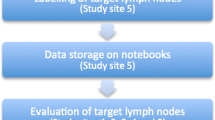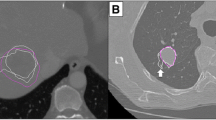Abstract
Objective
Quantification of tumour burden in oncology requires accurate and reproducible evaluation. The current standard is RECIST measurement with its inherent disadvantages. Volumetric analysis is an alternative for therapy monitoring. The aim of this study was to evaluate the feasibility of volumetric analysis of lymph node metastases using a software prototype in a follow-up setting.
Methods
MSCT was performed in 50 patients covering the chest, abdomen and pelvis. A total of 174 suspicious lymph nodes were evaluated by two radiologists regarding short axis diameters and volumetric analysis using semi-automated software. Quality of segmentation, time, maximum diameter and volume were documented. Variability of the derived change rates was computed as the standard deviation of the difference of the obtained respective change rates.
Results
The software performance provides robust volumetric analysis. Quality of segmentation was rated acceptable to excellent in 76–79% by each reader. Mean time spent per lesion was 38 s. The variability of change in effective diameters was 10.6%; for change rates of RECIST maximum diameter variability was 27.5%.
Conclusion
Semi-automated volumetric analysis allows fast and convenient segmentation of most lymph node metastases. Compared with RECIST the inter-observer-variability in baseline and follow-up is reduced. This should principally allow subtle changes to be subclassified within the RECIST stable range as minor response [−15% to +10%].





Similar content being viewed by others
References
Therasse P, Arbuck SG, Eisenhauer EA et al (2000) New guidelines to evaluate the response to treatment in solid tumors. European Organization for Research and Treatment of Cancer, National Cancer Institute of the United States, National Cancer Institute of Canada. J Natl Cancer Inst 92:205–216
Erasmus JJ, Gladish GW, Broemeling L et al (2003) Interobserver and intraobserver variability in measurement of non-small-cell carcinoma lung lesions: implications for assessment of tumor response. J Clin Oncol 21:2574–2582
Schwartz LH, Mazumdar M, Brown W, Smith A, Panicek DM (2003) Variability in response assessment in solid tumors: effect of number of lesions chosen for measurement. Clin Cancer Res 9:4318–4323
Eisenhauer EA, Therasse P, Bogaerts J et al (2009) New response evaluation criteria in solid tumours: revised RECIST guideline (version 1.1). Eur J Cancer 45:228–247
Bolte H, Riedel C, Knoss N et al (2007) Computed tomography-based lung nodule volumetry–do optimized reconstructions of routine protocols achieve similar accuracy, reproducibility and interobserver variability to that of special volumetry protocols? Rofo 179:276–281
Wormanns D, Kohl G, Klotz E et al (2004) Volumetric measurements of pulmonary nodules at multi-row detector CT: in vivo reproducibility. Eur Radiol 14:86–92
Bolte H, Riedel C, Muller-Hulsbeck S et al (2007) Precision of computer-aided volumetry of artificial small solid pulmonary nodules in ex vivo porcine lungs. Br J Radiol 80:414–421
Yankelevitz DF, Reeves AP, Kostis WJ, Zhao B, Henschke CI (2000) Small pulmonary nodules: volumetrically determined growth rates based on CT evaluation. Radiology 217:251–256
Bornemann L, Dicken V, Kuhnigk JM et al (2007) Software assistance for oncological therapy monitoring by volumetric assessment of tumor growth. Int J Comput Assist Radiol Surg 2007:231–242
Bornemann L, Kuhnigk JM, Dicken V et al (2005) Informatics in radiology (infoRAD): new tools for computer assistance in thoracic CT part 2. Therapy monitoring of pulmonary metastases. Radiographics 25:841–848
Keil S, Behrendt FF, Stanzel S et al (2009) RECIST and WHO criteria evaluation of cervical, thoracic and abdominal lymph nodes in patients with malignant lymphoma: manual versus semi-automated measurement on standard MDCT slices. Rofo 181:888–895
Keil S, Plumhans C, Behrendt FF et al (2009) Automated measurement of lymph nodes: a phantom study. Eur Radiol 19:1079–1086
Fabel M, von Tengg-Kobligk H, Giesel FL et al (2008) Semi-automated volumetric analysis of lymph node metastases in patients with malignant melanoma stage III/IV-A feasibility study. Eur Radiol 18:1114–1122
Bolte H, Riedel C, Jahnke T et al (2006) Reproducibility of computer-aided volumetry of artificial small pulmonary nodules in ex vivo porcine lungs. Invest Radiol 41:28–35
Marten K, Auer F, Schmidt S, Kohl G, Rummeny EJ, Engelke C (2006) Inadequacy of manual measurements compared to automated CT volumetry in assessment of treatment response of pulmonary metastases using RECIST criteria. Eur Radiol 16:781–790
Buerke B, Puesken M, Beyer F et al (2010) Semiautomatic lymph node segmentation in multislice computed tomography: impact of slice thickness on segmentation quality, measurement precision, and interobserver variability. Invest Radiol 45:82–88
Hein PA, Romano VC, Rogalla P et al (2009) Linear and volume measurements of pulmonary nodules at different CT dose levels—intrascan and interscan analysis. Rofo 181:24–31
Acknowledgment
We would like to thank M. Jochim and G. Morvan for image and data support.
Author information
Authors and Affiliations
Corresponding author
Rights and permissions
About this article
Cite this article
Fabel, M., Bolte, H., von Tengg-Kobligk, H. et al. Semi-automated volumetric analysis of lymph node metastases during follow-up—initial results. Eur Radiol 21, 683–692 (2011). https://doi.org/10.1007/s00330-010-1966-5
Received:
Revised:
Accepted:
Published:
Issue Date:
DOI: https://doi.org/10.1007/s00330-010-1966-5




